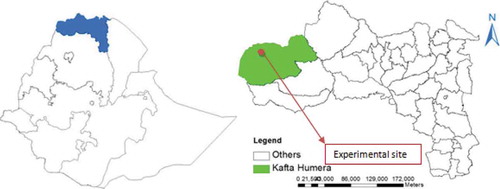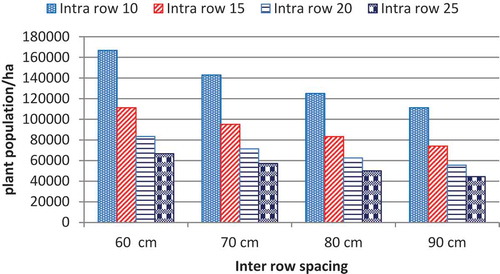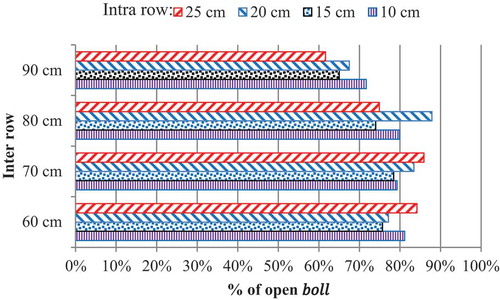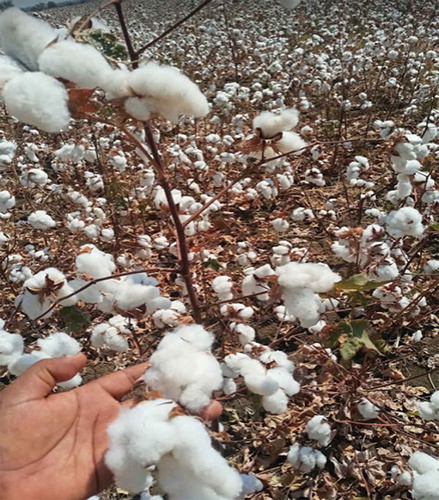 ?Mathematical formulae have been encoded as MathML and are displayed in this HTML version using MathJax in order to improve their display. Uncheck the box to turn MathJax off. This feature requires Javascript. Click on a formula to zoom.
?Mathematical formulae have been encoded as MathML and are displayed in this HTML version using MathJax in order to improve their display. Uncheck the box to turn MathJax off. This feature requires Javascript. Click on a formula to zoom.Abstract
The yield f cotton (Gossypium hirsutum L.) in Tigray is very low because of the lack of improved agronomic practices. Cotton producing farmers (if in row) adopt 90 × 20 cm. However, it is too wide for rain-fed cotton, which means more empty space left in-between the rows, which affect the yield negatively. Objective of this study was to estimate the optimum inter-row and intra-row spacing of cotton under rain fed condition. The experiment was laid out in split-plot design having three replications. The different levels of inter- and intra-row spacing have affected the agronomic traits and the seed cotton yield significantly. The narrow inter row and closer intra row have a higher plant population. The 90 cm inter row have taller (~90 cm) plant than the 60 cm inter row. The wider intra row (25 cm) scored higher (11–13) opened bolls in all the inter rows. The wider plant geometry recorded a higher number of unopened bolls (6). Heavier bolls (11 g) were recorded on the narrow inter-row spacing under all levels of intra-row spacing. Lighter boll weight was in 90 cm row spacing irrespective of the intra rows. Normally, boll weight was reduced as the inter-row spacing increased. Maximum seed cotton yield was recorded on 60 × 10 cm. Lower seed cotton yield was found on 90 × 25 cm. Generally, seed cotton yield was reduced as inter- and intra-row spacing increased. Therefore, the 60 × 10 cm inter and intra row should be recommended for maximum seed cotton yield under rain fed condition.
PUBLIC INTEREST STATEMENT
Cotton is an important industrial fibre crop widely cultivated along the world, which plays a very significant role in the export earning, local textile industry in the manufacture of garments and fabrics. Ethiopia has a conducive area for cotton cultivation with an estimated area of 2.67 million hectares. optimum level due to immense internal and external factors. An inappropriate agronomic practice is problems associated with the low productivity of cotton in Northern Ethiopia. Therefore, the development of location-specific agronomic practices like optimum planting geometry (optimum inter-and intra-row spacing) is required to improve cotton productivity.
Competing Interests
The authors declares no competing interests.
1. Introduction
Cotton (Gossypium hirsutum L.) is one of the most economically viable crops in our country, commonly produced for its lint yield. Cotton is an important industrial fiber crop widely cultivated along the world and which plays a very significant role in the political and socio-economic issues of many countries. It is important for the local textile industry in the manufacture of garments and fabrics. Cotton is the king of natural fiber (Saleem et al., Citation2009). Cotton production area in Ethiopia is about 80,000 ha with a production of 57,000 metric tons (USDA, Citation2018). The current cotton production area in Ethiopia is about 3% of the total suitable land for cotton production (Melesse et al., Citation2019). The cotton sector has great job opportunities in the country about 52,754 smallholder farmers, 408 mechanized rain-fed farms and 107 mechanized irrigated farms in 2015 (Berihu et al., Citation2015). Furthermore, huge temporary employment opportunities are also generated during the cotton production seasons (Melesse et al., Citation2019). Since 1928, research on cotton improvement has been made to develop high yielding cotton varieties and so far twenty-one varieties, seven hybrids and two transgenic varieties for irrigated areas and five varieties for rain fed areas have been released (Alehegn et al., Citation2019); however, Deltapine-90 cotton variety have been widely and dominantly grown for more than 20 years in Ethiopia.
Cotton grow very well in Afar, Benishangul-Gumuz, and in the lowlands of Western Tigray and Northern Amhara. Cotton is growing under rain fed condition in western Tigray. However, the yield in Tigray is very low because the production system is not supported with modern agriculture and specifically improved agronomic practices are not identified yet. Most of cotton producing farmers uses broadcasting, while some farmer uses 90 cm inter row and 20 cm intra row (between plants). The 90 by 20 cm is a plant spacing recommendation for high rainfall areas and irrigated cotton (Negash & Mulualem, Citation2014). In addition, it is too wide for rain fed cotton, which means more empty space left in-between the rows and it aggravates evapotranspiration and weed infestations. In Uganda, they changed the wider cotton spacing (90x30 cm) with a narrow one (60x15 cm), which gave high yield gain in comparison with previous recommendation (Hearn, Citation1972). Advantage of narrow row spacing is, the more rapid canopy closure that in turn reduces the weed competition and water evaporation (Darawsheh et al., Citation2009). The same authors added that cotton in narrow row spacing produced particular greater dry mass compared to the conventional system. Higher seed cotton yield was recorded in the narrow plant spacing compared to a wider spacing and increased bolls at the 1st, 2nd and 3rd positions of the plant with less yield and unnecessary vegetative growth that led to undesirable fruit shedding was observed in the wider spacing (Khan et al., Citation2020). Similarly, Clark and Carpenter (Citation1992) reported higher seed cotton yield in narrow row spacing compared to wider inter row. Therefore, this study was conducted to estimate the optimum inter and intra-row spacing of cotton for higher yield under rain fed condition of the lowlands of Western Tigray.
2. Materials and methods
2.1. Description of the study area
A field experiment to investigate optimum inter and intra-row spacing of cotton under rain fed condition was conducted in western Tigray at Humera Agricultural Research Center (HuARC) during the contiguous three growing seasons of 2016, 2017 and 2018. HuARC is located at a latitude of 14°15’ N, longitude of 36°37’ E and elevation of 608 m. The experimental site, Humera is under the administration of Kafta Humera. The agro-ecology of the location is described as hot to warm semiarid plain with a mean temperature of 29°C, annual mean rainfall of 581 mm (which ranges from 380 mm to 870 mm) (Figure )., verti soil, pH value of 7.8 and husbandry variations.
2.2. Experimental design
The experiment was laid out in split-plot design having three replications. The path between blocks and plots were (2.5 m and 2 m, respectively) and each plot had 5 m length and 7 rows with different sizes of area (5 m row length*7 rows* __m row spacing = 21, 24.5, 28 and 31.5 m2). The treatments in the main plot consisted of four inter-rows spacing (60, 70, 80 and 90 cm). Similarly, the subplot had four levels of intra-row spacing (10, 15, 20 and 25 cm). Generally, the experiment consisted of 16 treatment combinations. Deltapine-90 cotton (A branching variety released in 1989 by Werer Agricultural Research Center/EIAR) was used as a test variety, 100 kg NPS/ha (19 N + 36P2O5 + 7 S) blended fertilizer, 100 kg urea/ha (46 kg N/ha) and other agronomic practices were applied to all experimental units uniformly. Cotton was planted in early July in all of the experimentation years. The field was ploughed and harrowed three times to obtain fine tilt, thereafter marked into plots. Data such as number of branches per plant, plant height, number of open bolls per plant, number of unopened bolls per plant, boll weight, % of open boll and seed cotton yield per hectare (kg/ha) were collected. Boll opening percentage was calculated (from five sample plants) as follows:
2.3. Data analysis
The collected data on selected yield and yield attributes of cotton were summarized and analyzed using GenStat 18th statistical software. Mean comparison for the treatment means having significant differences at 5% level of significance was done using Duncan’s Multiple Range Test (DMRT) comparison procedure to see the difference between the different treatments and the presence of significance difference between the treatments.
3. Results
3.1. Rainfall status of the study area
Annual rainfall for the study area was presented in figure (), it was a little bit higher (600–700 mm) in 2016 and 2018 production seasons but very low (<500 mm) during 2017 production year.
3.2. Effect of inter- and intra-row spacing on seed cotton yield
Agronomic performances including No. of Branch/plant, No. of open bolls/plant, Boll weight (g/boll) and seed cotton yield (kg/ha) had highly influenced by the different inter-row spacing and intra-row spacing (Table .).
Table 1. ANOVA table of the agronomic traits of cotton
Inter R = inter row, intra R = intra row, *** = highly significant at p < 0.001, ** = Highly significant different at p < 0.01, * = Significant different at p < 0.05, NS = Non-significant difference
Agronomic performances of cotton had highly influenced by the different inter and intra-row spacing (Table ). Higher seed cotton yield (3401 kg/ha) was recorded on the 60 cm inter-row spacing and lower seed cotton yield (825 kg/ha) on 90 cm inter-row spacing. Regarding the intra row, higher seed cotton yield (3206 k/ha) was harvested from the 10 cm intra-row spacing, while the lower (938 kg/ha) was from 25 cm intra-row spacing (Table ). Concerning the production seasons, yield difference was observed among years. There was higher seed cotton yield (2995 kg/ha) in 2016 production year, while lower yield (1100 k/ha) was harvested in 2017 and intermediate yield (2028 kg/ha) was harvested from the 2018 production year (Table ).
Table 2. Response of seed cotton yield to the inter-row and intra-row effects
Means followed by the same letter are not significantly different
3.3. Interaction effect of year, inter row and intra row on cotton agronomic traits and yield
Population densities of cotton were highly influenced by the interaction effect of inter and intra-row spacing (Figure ). The wider inter and intra-row spacing (90x25 cm) gave very low plant populations (44,444 plants/ha). On the other hand, the 60 × 10 cm row spacing gave good plant population densities 166,666 plants/ha (Figure ).
The combined ANOVA showed that there was a significant variation among treatments on, plant height, boll weight, total bolls per plant and seed cotton yield (Table ). Higher plant height (90 cm) was found on the wider inter-row and narrow intra-row spacing (90 × 10 cm), whereas the shorter (78 cm) was recorded in the narrow inter- and intra-row spacing (60 ×15 cm). The rest of other treatments are statistically similar in stature (Table ).
Table 3. Combined means of seed cotton yield and yield components
Means followed by the same letter are not significantly different.
The combined ANOVA result shows that there were significant variations among treatment on unopened and opened bolls per plant (Table ). Higher number of unopened bolls (6 bolls/plant) was recorded in the 90 × 25 cm. Most of the intra rows except the 25 cm intra-row spacing have scored fewer unopened bolls (<4 bolls/plant) in all levels of inter-row spacing (Figure )). In the case of open bolls; a higher number of open bolls (11–13 bolls/plant) were recorded in all levels of inter-row spacing with the wider intra-row spacing (60x25 cm, 70 × 25 cm, 80 × 25 cm, 90 × 25 cm). In other side the lower number of open bolls (7–8 bolls/plant) were recorded in 60x10, 60x15, 60 × 20 cm and 70 × 10 cm. Mostly, the result showed that cotton plant in small space area bear lower open bolls than the wider space area (Figure )).
Figure 4. Combined means of unopened bolls per plant (a) and open bolls per plant (b) of intra row at different levels of inter-row spacing of cotton.
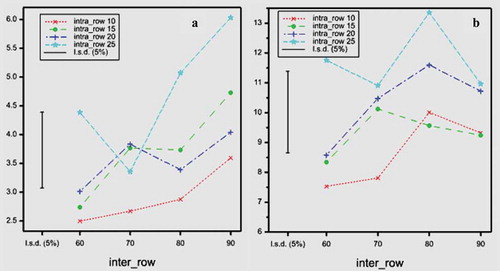
Regarding the total number of bolls, there were clear differences among treatments (Table .). The wider inter and intra rows (90 × 25 cm and 80 × 25 cm) scored higher number of bolls (18 bolls/plant), while the narrow inter and intra rows (60 × 10, 60 × 15 cm, 60 × 20 cm and 70x10 cm) scored lower number of bolls (9-11 bolls/plant). Generally, plants that has wider planting geometry scored higher bolls per plant, whereas plats with narrow planting space gave lower bolls per plant (Table .). The three-year data witnessed that the higher percentage of open boll (85%) were recorded on 80 × 25 cm, 70 × 25 cm, 60 × 25 cm and 60 × 10 cm, where the 90 cm inter row under all levels of intra row scored minimum percentage of open bolls (Figure .).
Heavier bolls (11 g/boll) were recorded on the narrow inter-row spacing (60 cm) under all levels of the intra-row spacing. On the other side, lighter boll weights (7–8 g/boll) were in the wider inter-row spacing (80 and 90 cm) irrespective of the intra rows. Usually, boll weight was reduced as the inter-row spacing was increased (Table ).
Comparing the combined seed cotton yield among the treatments, maximum yield (2611 kg/ha) was recorded on 60 × 10 cm row spacing, it was statistically similar with 70 × 10 cm row spacing. The lower seed cotton yield (1720 kg/ha) was found on 90 × 25 cm intra-row spacing. Moreover, most of the inter- and intra-row spacing treatments were statistically similar with that of the low yielder (90 × 25 cm) except the two high yielder (60x10 and 70 × 10 cm) treatments. Normally, the yield was observed to be reduced as inter- and intra-row spacing was increased (Table ).
4. Discussion
The different levels of inter and intra-row spacing have affected the agronomic traits of cotton and the seed cotton yield significantly (Table ). The wider inter rows (90 & 80 cm) and wider intra rows (25 and 20 cm) scored low yields in all production years, while the narrow inter row (60 cm) and narrow intra row (10 cm) gave good yields. We can conclude that, as inter-row and/or intra-row spacing increased, seed cotton yield was reduced significantly (Table .). The higher yield in the narrow inter-row and/or intra-row spacing was definitely because of the higher plant population (Figure ). In the wider inter-row and/or intra-row spacing; plants might get more resources without competitions. However, the study area has limited rainfall (Figure and ) and the wider space between rows and/or plants expose to high rate of evaporation, potential evapotranspiration (PET) of the area particularly from mid-September is higher (Figure ). Krieg (Citation1996) determined that up to 40% of the available water supply is lost through soil evaporation in a wider row spacing of cotton. In the contrary, soil temperature might keep low by the shade of the canopy of the denser plant population and the canopy closure helps to minimize the rate of evaporation. Narrow inter row and high plant density produced particularly higher biomass compared to low plant density (Darawsheh et al., Citation2009). Saleem et al. (Citation2009) reported that 60 cm inter row has about 12% of yield advantage compared to 90 cm inter-row spacing of cotton. In addition, narrow cotton row spacing is helpful to minimize weed infestation (Wilson et al., Citation2007) and shortens the maturity period (Saleem et al., Citation2009).
Figure 6. Average length of the growing period, temperature, precipitation, PET of the study area (Humera) over a long period of time (New LocClim Longitude 36.37o E, Latitude14.15o N, Altitude 608 m).
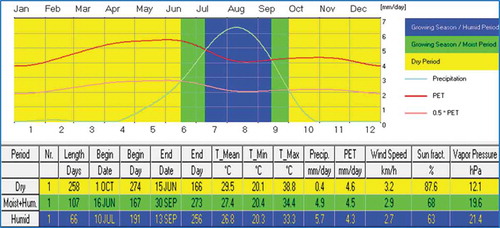
The 90 × 10 cm plant geometry showed higher stature (Table ), this might because of low resource competition between the wider inter and narrow intra row. In addition, the denser plants within a row might minimize evaporation, which in turn contributed to taller height. In the other way, the interactions of narrow inter and intra rows (60x10 cm) and wider inter and intra rows (90x25 cm) have shorter plant height. Probably, this could due to higher nutrient competitions among plants in the narrow intra and intra rows and high evaporation rates in the wider inter and intra rows. This is in line with Saleem et al. (Citation2009) who reported broader rows (90 cm) produced maximum height of first fruiting branch and plant height, where the narrow rows (60 cm) resulted in minimum height. Similarly, Elhassan and Abdelatif (Citation2006) reported that the closer spacings (narrow inter and intra row) produced shorter plants. In the contrast, the narrow row spacing (60) has a taller height (121) than the wider (90 cm), which has 111 cm (Munir et al., Citation2015). Higher number open bolls were recorded in all inter rows with the wider intra row (25 cm), while a lower number of open bolls (7–8 bolls/plant) were recorded in the 60 × 10 cm. Generally, number of open bolls were increased as inter and intra row increased but declined as the inter row goes beyond 80 cm (Figure ). The lower number of open bolls in the narrow inter rows with a higher plant population could be due to high resource competition within the limited space. Since the growing area is a dry land with low annual rainfall (Figure ), in which later appeared bolls remained unopened then the total number of opened balls decreased. In the other way, the narrow cotton spacing (60x10 cm) scored very low unopened bolls, where the wider plant spacing (90x25 cm) scored a higher number of unopened bolls. Generally, unopened boll increased steeply as inter and intra rows increased (Table ). This is obviously because of the wider space that helps the plant to get a chance to exploit all resources and thereby increase the chance to bear more bolls. However, the maximum boll production in the wider space creates competition among bolls for assimilate and other products. Especially, in stress condition the lower (old) bolls fully open while young bolls at the top part of the plant remain unopened and poor in quality. This is in line with (Siddiqui et al., Citation2007) who reported that the number of unopened balls increased linearly as the intra-row spacing increased. Regarding the total bolls, higher values were scored in the wider space area (90x25 cm, 80 × 25 cm and 70 × 25 cm) (Table ). It could be due to better availabilities of soil resources and good aerations. This result is an indicator that wider spacing can produce a higher number of bolls in high rainfall areas or irrigated areas of the country. The optimum inter-row spacing of cotton was 90 cm under high rainfall areas and/or irrigation production (Negash & Mulualem, Citation2014). In high rainfall areas, the narrow row spacing (60 cm) has a lower number of bolls (16), where the wider row spacing (90 cm) scored higher (25) bolls per plant (Munir et al., Citation2015).
Heavier bolls (11 g/boll) were recorded in the narrow inter row under all levels of plant population, while lighter bolls were scored in the wider inter rows regardless of the intra row (Table ). Plants in the wider spacing bred a higher number of bolls, which many of them were unopened perhaps because of limited sink allocations. However, in the narrow plant spacing, plants had given fewer and heavier bolls in number and in weight, respectively (Table ). Perhaps, plants in the narrow inter and intra rows might have enough sinks to feed bolls, which make them bigger in size or weight. This result is in contrary with Munir et al. (Citation2015) who reported that wider row spacing (90 cm) produced heavier bolls and the narrow (60 cm) scored lighter bolls under irrigation. This indicated that narrow plant spacing is preferable for higher yield under rain fed conditions.
The narrow plant spacing (60 × 10 cm) have about 52% yield advantage over the wider plant spacing (90 × 25 cm). This was because of the higher plant populations that bear fewer but heavier bolls in the narrow plant spacing compared to the wider plant spacing (Table ). This is in line with studies of Hearn (Citation1972) who changed the previous wider cotton spacing (90x30 cm) recommendation with a narrow and economical spacing (60 × 15 cm); and with Clark and Carpenter (Citation1992) who reported higher seed cotton yield in narrow row spacing compared to wider inter row. The lower inter and intra-row spacing of cotton gave higher seed cotton yield (Elhassan & Abdelatif, Citation2006). And Nichols et al. (Citation2004) stated that higher seed cotton yield was harvested from the narrow row spacing. Closer row spacing and denser plant population leads to rapid canopy closure than the wider spacing and this, in turn, leads to reduced weed competition, increased light interception and potentially decreased soil water evaporation (Jost & Cothren, Citation2000), eventually it gave higher cotton seed yield.
5. Conclusion
The cotton agronomic traits and population densities were highly influenced by the interaction effect of inter and intra-row spacing. The narrow inter-row and closer intra row have a higher plant population. The wider inter and intra row have taller plant height than the narrow one. The 25 cm intra row scored higher opened bolls in all inter rows. The 90 × 25 cm plant geometry recorded a higher number of unopened bolls. Heavier bolls were recorded on 60 cm inter-row spacing under all levels of the intra-row spacing, while lighter boll weights were in 90 cm inter-row spacing irrespective of the intra rows. Normally, boll weight was reduced as the inter-row spacing was increased. Maximum seed cotton yield was recorded on 60 × 10 cm. And the lower seed cotton yield was found on 90 × 25 cm. Generally, seed cotton yield was reduced as inter and intra row spacing was increased. Therefore, to harvest maximum cotton yield, inter and intra-row spacing of rain fed cotton should be 60 × 10 cm, respectively.
Additional information
Funding
Notes on contributors
Zenawi Gebregergis
Zenawi G., Fiseha B. and Goitom T. are researchers in Tigray Agriculrural Research Institute (TARI), Humera Agricultural Research Center (HuARC) working in a group or team. The team is mainly doing different agronomy, crop protection and crop improvement activities and community-based works for low land oil and fibre crops in Northern parts of the country, particularly the research team works its research experiments dominantly on cotton and sesame commodities.
References
- Alehegn, W. A., Hussien, M., & Berhanu, A. (2019). Evaluation of segregating generations of upland cotton (Gossypium hirustum L.).
- Berihu, A., Mihretu, M., & Weldesilassie, A. (2015). Value chain analyses for a climate resilient production of cotton and sugarcane commodities in Ethiopia. Ethiopian Development Research Institute.
- Clark, L. J., & Carpenter, E. W. (1992). Cotton row spacing studies, safford agricultural center.
- Darawsheh, M., Khah, E., Aivalakis, G., Chachalis, D., & Sallaku, F. (2009). Cotton row spacing and plant density cropping systems I. Effects on accumulation and partitioning of dry mass and LAI. Journal of food, agriculture and environment, 7(3), 258–12. https://pubag.nal.usda.gov/catalog/774947
- Elhassan, O., & Abdelatif, A. H. 2006. Effects of inter-row and intra-row spacing on growth, yield and fiber quality of rain-fed cotton in the Blue Nile State.
- Hearn, A. (1972). Cotton spacing experiments in Uganda. The Journal of Agricultural Science, 78(1), 13–25. https://doi.org/10.1017/S0021859600087633
- Jost, P. H., & Cothren, J. T. (2000). Growth and yield comparisons of cotton planted in conventional and ultra-narrow row spacings. Crop Science, 40(2), 430–435. https://doi.org/10.2135/cropsci2000.402430x
- Khan, N., Han, Y., Xing, F., Feng, L., Wang, Z., Wang, G., Yang, B., Fan, Z., Lei, Y., & Xiong, S. (2020). Plant density influences reproductive growth, lint yield and boll spatial distribution of cotton. Agronomy, 10(1), 14. https://doi.org/10.3390/agronomy10010014
- Krieg, D. (1996). Physiological aspects of ultra narrow row cotton production. Proceedings 1,66–66 National Cotton Council, Memphis TN.
- Melesse, Z., Adem, M., Aynalem, M., & Mossie, H. (2019). Cotton production and marketing trend in Ethiopia: A review. Cogent Food & Agriculture, 5, 1691812. https://doi.org/10.1080/23311932.2019.1691812
- Munir, M., Tahir, M., Saleem, M., & Yaseen, M. (2015). Growth, yield and earliness response of cotton to row spacing and nitrogen management. The Journal of Animal & Plant Sciences, 25(3) 729–738. https://www.semanticscholar.org/paper/
- Negash, F., & Mulualem, T. (2014). The effect of plant spacing and planting method on yield and yield components of cotton.
- Nichols, S., Snipes, C., & Jones, M. (2004). Cotton growth, lint yield, and fiber quality as affected by row spacing and cultivar. Journal of Cotton Science, 8, 1–12. https://agris.fao.org/agris-search/search.do?recordID=US201300950750
- Saleem, M. F., Anjum, S. A., Shakeel, A., Ashraf, M. Y., & Khan, H. Z. (2009). Effect of row spacing on earliness and yield in cotton. Pakistan Journal of Botany, 41(5), 2179–2188. https://pdfs.semanticscholar.org/6118/0d35b8d1e9689d80d1c31502a5d18d38d41a.pdf
- Siddiqui, M., Oad, F., & Buriro, U. (2007). Plant spacing effects on growth, yield and lint of cotton. Asian Journal of Plant Sciences, 6(2), 415–418. https://doi.org/10.3923/ajps.2007.415.418
- USDA. (2018). Ethiopia’s cotton production down—imports likely up; GAIN Report No ET1801.
- Wilson, D. G., York, A. C., & Jordan, D. L. (2007). Effect of row spacing on weed management in glufosinate-resistant cotton. Weed Technology, 21(2), 489–495. https://doi.org/10.1614/WT-06-089.1

